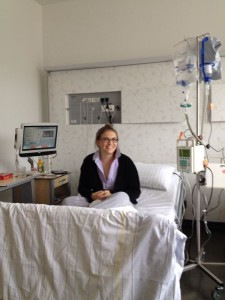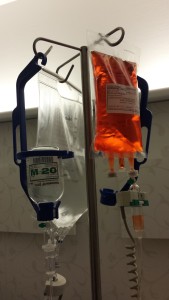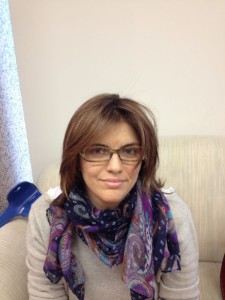My doctors informed me that the treatment period would be long, tough, and energy draining. Before starting with my therapy, I got a “portcath” (also just simply called port) implanted beneath the skin on my chest. It is basically a catheter that connects the port to a vein, through which drugs and the chemo itself can injected or even blood samples can be drawn.
This small surgery was conducted with a local anesthesia, and I was totally awake and even chatting with the surgeon.

First Chemo Day in Hospital
On 28 October 2014 I was hospitalized for my first chemotherapy. Since an Osteosarcoma is a highly aggressive tumor type, the chemotherapy requires to be strong and given in high-dosage and transfused slowly. In the past years doctors have studied the composition of the various cytotoxic agents to determine which combinations bring the highest results and hence they have created a protocol called EURAMOS.
One cycle of chemotherapy was divided into 3 sessions consisting of:
Week 1: Cisplatin + Adriamycin
Week 5: Methotrexate
Week 6: Methotrexate
Week 2, 3, 4 was a recovering period, as the first two medications highly affect the white blood cells, which weaken your immune system and put you at high risk for infections etc. Before your body can handle further chemo drugs, you need these 3 weeks of recovery period.
Anyway, once you finish your first cycle, you start over again and repeat the infusions in the same order again. But let me go more into detail for each session.
Week 1: Cisplatin + Adriamycin

Adriamycin
The transfusions start with simply a mixture of water and saline solution, as it helps to flush out the toxin chemo substances faster.
The first chemo sac is Cisplatin, a clear and light sensitive liquid, and is transfused within 4 hours. Then you are connected to Adriamycin, which is a bright orange liquid and highly acidic. Just a little drop of this can burn your skin. Adriamycin needs to flow into your body very slowly (apparently the best results have been shown by following this method), and therefore, one sac takes 24 hours. However, in my case I got two of those sacs and for 48 hours I was tied up with my new infusion stand. Simultaneously, you receive liquid transfusions; so you end up running for a wee every 30 minutes.
I tell you this is a strange feeling to know that for 48 hours you are being pumped with an orange acidic substance that is running through your veins. How can this burn off your skin, but not your veins?
Last but not least, after my horrific 48 hours of Adriamycin, I end my first session with another 4 hours of Cisplatin.
The side effects of these two cytotoxic agents are the usual ones that everyone hears about from cancer patients: nausea, vomiting, diarrhea, body ache, skin rashes and hair loss.
I have to admit that my first session was probably the worst one: I had no appetite, I was feeling nauseous all the time, and I wasn’t able to taste anything… I was basically totally overstrained with the situation.
Week 5 & 6: Methotrexate
This chemo substance (with a yellow color) does not cause as much nausea like the other one, and surprisingly I handled it much better.
Methotrexate (shortcut MTX) is being transfused in high dosage in one sac within 4 hours, and that’s it. However, this drug highly affects the kidneys and you got to continue to stay in hospital for about 5-6 days and receive fluids. Every 6 hours blood will be drawn to check the MTX level, and only after reaching a value below 0.1 you are allowed to go home. This chemo did not make me feel too sick, but gave me heavy headaches. Hence it was more annoying to kill time in hospital until reaching the targeted MTX level than facing the side effects.
So this was the process I had to follow for the next months. The target was to accomplish 2 cycles of chemotherapy before going for the surgery, and then followed by 5 more cycles after surgery.
Doing chemotherapy before the surgery is called a neoadjuvant therapy. The aim is to kill the tumor cells already before resection and it can give valuable insights on how the tumor reacts to the given cytotoxic agents. The tumor may even shrink and can make a surgery easier and more feasible.
The cycles after the surgery are called adjuvant chemotherapy and are given to destroy the left-over (microscopic) cells to prevent a possible reoccurrence.
I had to get this into my head that this process and fight will determine my next months… the goal was to make it through to June and to be declared as “cancer-free”.
However, there were many other obstacles to overcome… the first two ones happened 10 days after my first chemotherapy session.
I didn’t realize how badly infections could be, when your body has no white blood cells that are in charge of your immune system. I got very high fever and stomatitis (a very bad infection in your mouth). You cannot swallow your food, nor drink… everything just hurts so badly in your mouth. I would realize only later that this will continuously happen after every strong chemotherapy, and at the same time you get used to these side effects.
The other obstacle was mentally: my hair loss. We all know that most chemo patients loose their hair as the cytotoxic agents do not only kill the tumor cells but also other good cells, such as the hair growing cells. I knew this as well and I thought I would be ready to face it, but when I woke up one morning noticing hair on my pillow I realized that I wasn’t prepared at all.
All my life I had long hair, and suddenly I would loose all of it and be bold and everyone would notice I am a cancer patient. Since my malignant diagnosis in October, this was the first time I cried… and I really cried a lot. It felt so definitive and as of now I am a cancer patient!
A few days later, when I felt strong enough, I went into town to choose a wig and decided to shave my head. It was hurting too much to see my hair falling out daily and I rather wanted to make a one-time cut. That afternoon I cried so much again, but once I let everything out I started to accept my “new me”.

My new wig